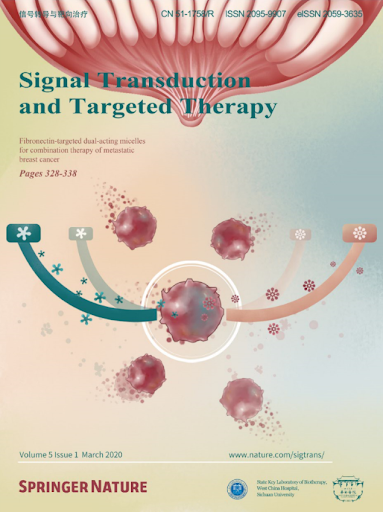Preclinical and first-in-human of purinostat mesylate, a novel selective HDAC I/IIb inhibitor, in relapsed/refractory multiple myeloma and lymphoma.
IF 40.8
1区 医学
Q1 BIOCHEMISTRY & MOLECULAR BIOLOGY
引用次数: 0
Abstract
Simultaneously targeting key pathogenic drivers and remodeling of the tumor microenvironment represents a critical therapeutic strategy for relapsed or refractory (r/r) multiple myeloma (MM) and lymphoma. Purinostat mesylate (PM), a highly selective HDAC I/II binhibitor, exhibits excellent antitumor activity in MM and lymphoma cell lines and mouse models, outperforming the pan-HDAC inhibitor panobinostat or first-line/second-line multi-drug combinations. Different from panobinostat, bulk RNA-seq analysis revealed that PM suppressed essential tumor survival factors and triggered inflammation and interferon responses. The scRNA-seq of 5TMM models further indicated that PM enhanced antitumor immunity by boosting monocyte- and T cell-mediated immune responses. In a phase I trial (NCT05526313; N = 29) of PM at doses up to 15 mg/m², treatment-related Grade ≥3 adverse events predominantly comprised hematologic toxicities: thrombocytopenia (75.9%), neutropenia (55.2%), leukopenia (41.4%), and lymphopenia (31.0%), with no dose-limiting toxicities observed. PM monotherapy achieved a disease control rate of 72.7% (8/11) and an objective response rate (ORR) of 9.1% (1/11) in r/r MM. Notably, r/r lymphoma patients showed an ORR of 61.6% (11/18), particularly reaching 63.6% (7/11) with 6 complete responses in diffuse large B-cell lymphoma (DLBCL). Treatment responders exhibited enhanced immune activation, with elevated CD3+CD8+ T cells and increased cytokine levels, such as IFN-γ and CXCL10. Overall, PM is safe and moderately effective in MM, but highly effective in lymphoma. Additionally, PM combined with pomalidomide and dexamethasone showed strong synergistic activity in r/r MM treatment. These findings support further open-label, multicenter phase Ib/IIa trials of PM combination therapy with immunomodulators for r/r MM, as well as phase II monotherapy trials for r/r DLBCL and r/r T-cell lymphoma.甲磺酸purinostat是一种新型的选择性HDAC I/IIb抑制剂,用于复发/难治性多发性骨髓瘤和淋巴瘤的临床前和首次人体试验。
同时靶向关键致病因素和肿瘤微环境重塑是复发或难治性(r/r)多发性骨髓瘤(MM)和淋巴瘤的关键治疗策略。Purinostat mesylate (PM)是一种高选择性HDAC I/II抑制剂,在MM和淋巴瘤细胞系和小鼠模型中表现出出色的抗肿瘤活性,优于泛HDAC抑制剂panobinostat或一线/二线多药联合。与panobinostat不同的是,大量RNA-seq分析显示PM抑制肿瘤生存因子并引发炎症和干扰素反应。5TMM模型的scRNA-seq进一步表明,PM通过增强单核细胞和T细胞介导的免疫应答来增强抗肿瘤免疫。I期临床试验(NCT05526313;N = 29),治疗相关的≥3级不良事件主要包括血液学毒性:血小板减少(75.9%)、中性粒细胞减少(55.2%)、白细胞减少(41.4%)和淋巴细胞减少(31.0%),未观察到剂量限制性毒性。PM单药治疗r/r MM的疾病控制率为72.7%(8/11),客观缓解率(ORR)为9.1%(1/11)。值得注意的是,r/r淋巴瘤患者的ORR为61.6%(11/18),特别是弥漫性大b细胞淋巴瘤(DLBCL)患者的ORR达到63.6%(7/11),有6个完全缓解。治疗应答者表现出增强的免疫激活,CD3+CD8+ T细胞升高,细胞因子水平升高,如IFN-γ和CXCL10。总的来说,PM对MM是安全的,中等疗效,但对淋巴瘤非常有效。此外,PM联合泊马度胺和地塞米松在r/r MM治疗中表现出较强的协同作用。这些发现支持进一步的开放标签、多中心Ib/IIa期PM联合免疫调节剂治疗r/r MM的试验,以及r/r DLBCL和r/r t细胞淋巴瘤的II期单药治疗试验。
本文章由计算机程序翻译,如有差异,请以英文原文为准。
求助全文
约1分钟内获得全文
求助全文
来源期刊

Signal Transduction and Targeted Therapy
Biochemistry, Genetics and Molecular Biology-Genetics
CiteScore
44.50
自引率
1.50%
发文量
384
审稿时长
5 weeks
期刊介绍:
Signal Transduction and Targeted Therapy is an open access journal that focuses on timely publication of cutting-edge discoveries and advancements in basic science and clinical research related to signal transduction and targeted therapy.
Scope: The journal covers research on major human diseases, including, but not limited to:
Cancer,Cardiovascular diseases,Autoimmune diseases,Nervous system diseases.
 求助内容:
求助内容: 应助结果提醒方式:
应助结果提醒方式:


